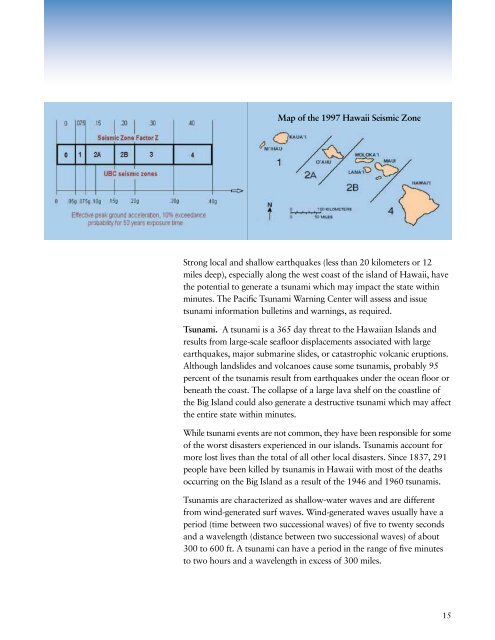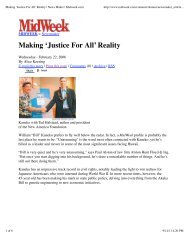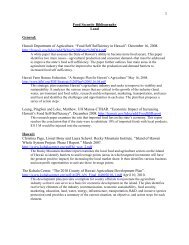Report on the State of Physical Infrastructure in Hawaii
Report on the State of Physical Infrastructure in Hawaii
Report on the State of Physical Infrastructure in Hawaii
Create successful ePaper yourself
Turn your PDF publications into a flip-book with our unique Google optimized e-Paper software.
Map <strong>of</strong> <strong>the</strong> 1997 <strong>Hawaii</strong> Seismic Z<strong>on</strong>eStr<strong>on</strong>g local and shallow earthquakes (less than 20 kilometers or 12miles deep), especially al<strong>on</strong>g <strong>the</strong> west coast <strong>of</strong> <strong>the</strong> island <strong>of</strong> <strong>Hawaii</strong>, have<strong>the</strong> potential to generate a tsunami which may impact <strong>the</strong> state with<strong>in</strong>m<strong>in</strong>utes. The Pacific Tsunami Warn<strong>in</strong>g Center will assess and issuetsunami <strong>in</strong>formati<strong>on</strong> bullet<strong>in</strong>s and warn<strong>in</strong>gs, as required.Tsunami. A tsunami is a 365 day threat to <strong>the</strong> <strong>Hawaii</strong>an Islands andresults from large-scale seafloor displacements associated with largeearthquakes, major submar<strong>in</strong>e slides, or catastrophic volcanic erupti<strong>on</strong>s.Although landslides and volcanoes cause some tsunamis, probably 95percent <strong>of</strong> <strong>the</strong> tsunamis result from earthquakes under <strong>the</strong> ocean floor orbeneath <strong>the</strong> coast. The collapse <strong>of</strong> a large lava shelf <strong>on</strong> <strong>the</strong> coastl<strong>in</strong>e <strong>of</strong><strong>the</strong> Big Island could also generate a destructive tsunami which may affect<strong>the</strong> entire state with<strong>in</strong> m<strong>in</strong>utes.While tsunami events are not comm<strong>on</strong>, <strong>the</strong>y have been resp<strong>on</strong>sible for some<strong>of</strong> <strong>the</strong> worst disasters experienced <strong>in</strong> our islands. Tsunamis account formore lost lives than <strong>the</strong> total <strong>of</strong> all o<strong>the</strong>r local disasters. S<strong>in</strong>ce 1837, 291people have been killed by tsunamis <strong>in</strong> <strong>Hawaii</strong> with most <strong>of</strong> <strong>the</strong> deathsoccurr<strong>in</strong>g <strong>on</strong> <strong>the</strong> Big Island as a result <strong>of</strong> <strong>the</strong> 1946 and 1960 tsunamis.Tsunamis are characterized as shallow-water waves and are differentfrom w<strong>in</strong>d-generated surf waves. W<strong>in</strong>d-generated waves usually have aperiod (time between two successi<strong>on</strong>al waves) <strong>of</strong> five to twenty sec<strong>on</strong>dsand a wavelength (distance between two successi<strong>on</strong>al waves) <strong>of</strong> about300 to 600 ft. A tsunami can have a period <strong>in</strong> <strong>the</strong> range <strong>of</strong> five m<strong>in</strong>utesto two hours and a wavelength <strong>in</strong> excess <strong>of</strong> 300 miles.15







